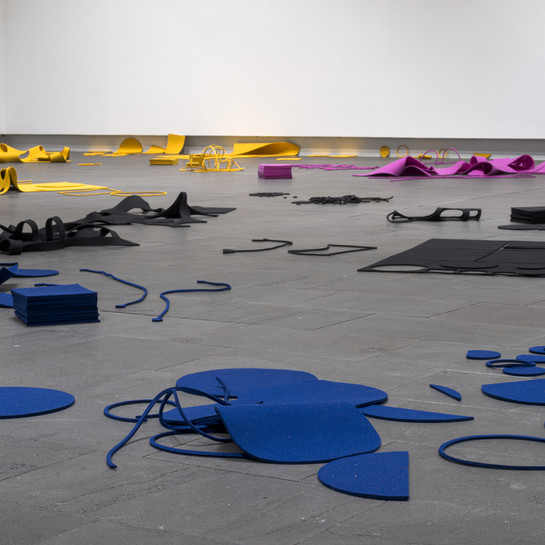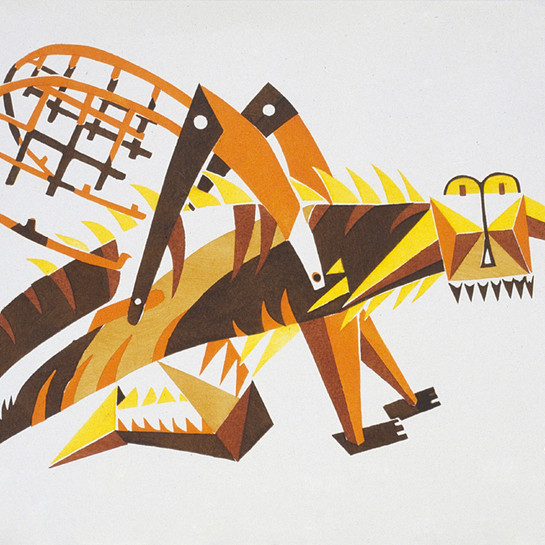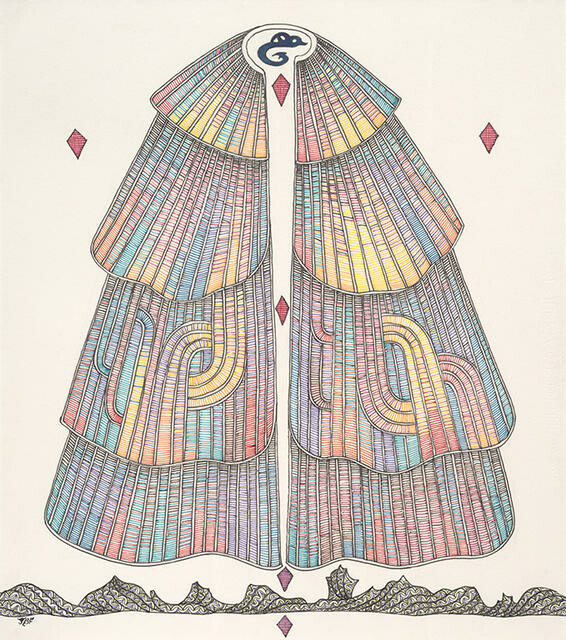John Bevan Ford
Aotearoa New Zealand, b.1930, d.2005
Ngāti Raukawa Ki Kapiti,
Māori
Spöring’s View of Motuaro (from the Endeavour, 1769)
- 1992
- Ink on paper
- Purchased, 1994
- 1080 x 880mm
- 94/15
Location: Sir Robertson and Lady Stewart Gallery
Tags: cloaks, hills, landscapes (representations), Māori (culture or style), patterns (design elements), rainbows, stripes
This work from John Bevan Ford’s Ngā Tohunga Waka series shows a finely detailed kākahu hovering over Motuarohia in Pēwhairangi Bay of Islands. This is a motif Bevan Ford returned to often: “I suspend these cloaks over the land and sea to express the mana of those places and of the people who live there and have lived there.” The title refers to Herman Spöring, a naturalist on board the Endeavour during Captain Cook’s first voyage to the Pacific. In 1769 Cook landed at Motuarohia, imposing his name on ‘Cook’s Cove’, and renaming the entire area the ‘Bay of Islands’. In this work, however, Bevan Ford asserts the much longer Indigenous presence on the island, which has a rich history of Māori life and occupation.
Ngā Tohunga Waka ~ expert navigators
kākahu ~ cloak
mana ~ prestige, respect, authority
He Kapuka Oneone – A Handful of Soil (from August 2024)
Exhibition History
Art Detectives, 20 October 2006 - 25 March 2007
A rainbow coloured peke (Maori rain cape) floats above an outline of rocky hills as seen from a distant ship. Here, Maori artist John Bevan Ford recalls drawings by Herman Spöring, an artist on board Captain Cook’s ship Endeavour in 1769 at the Bay of Islands.
Ford was inspired by his time spent at the British Museum in the 1980s studying Maori taonga or treasures, including weaving and carvings collected by Cook. While referring to European exploration, this drawing also speaks of a long presence for Maori in this land, with the peke a symbol of mana and protection.
Die Cuts and Derivations,11 March – 2 July 2023
Spöring’s View of Motuaro (from the Endeavour, 1769) is from John Bevan Ford’s Ngā Tohunga Waka (expert navigators) series, and recalls the coastal landscape drawings of Herman Spöring, an artist on board Captain Cook’s ship Endeavour. Ford’s delicate and intricate ink drawings take customary Māori art forms such as whakairo (carving), raraka (weaving) and kōwhaiwhai (rafter paintings) as their starting point. His work often engages with cross-cultural dialogue; here the European scientific depictions of coastal landscapes, seen at the bottom, are enveloped by a colourful kākahu (cloak form), a symbol of protection the acknowledges the long presence of Māori, as takata whenua, and the mana they hold over the land.
(Die Cuts and Derivations, 11 March – 2 July 2023)



